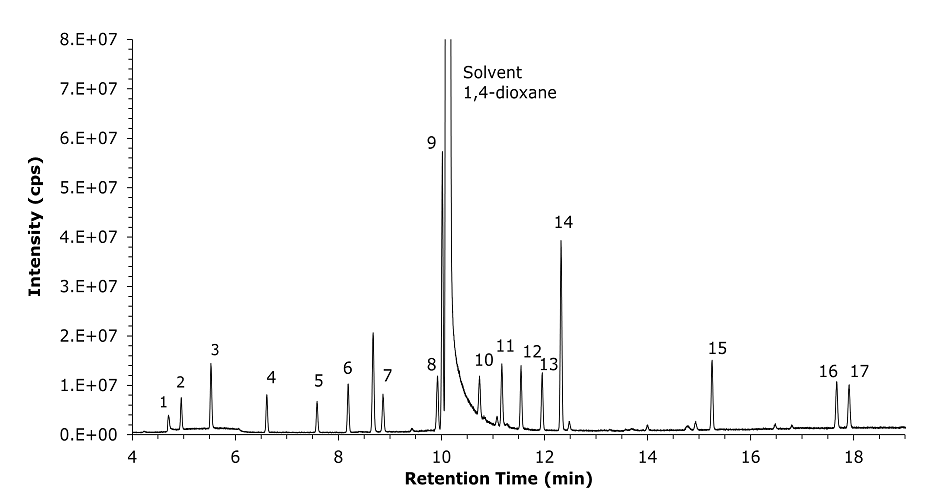GC-MS Determination of Lithium-Ion Battery Electrolyte Solvents and Their Impurities on a SPB®-624 Capillary GC Column
Valanka D’Silva
R&D and Customer Support Lab APAC, Jigani, Bangalore, India
Abstract
A simple and efficient gas chromatography–mass spectrometry method (GC-MS) has been developed for the separation of battery electrolyte solvents used for lithium-ion batteries and their impurities on an SPB®-624 capillary column.
Section Overview:
Introduction
Electrolyte solutions are essential in rechargeable lithium-ion batteries, which are widely utilized in portable electronics and the electric vehicle market.1 These electrolytes facilitate the transport of lithium ions between the cathode and anode, requiring both a high dielectric constant and low viscosity to enable high voltage and specific energy advantages. Commonly used mixtures of linear and cyclic carbonates, such as ethylene carbonate (EC), dimethyl carbonate (DMC), diethyl carbonate (DEC), and ethyl methyl carbonate (EMC), serve this purpose.
The quality of the electrolyte significantly influences battery performance, particularly the presence of trace impurities such as alcohols and esters. These protic impurities, including water, often originate from the solvent manufacturing process or result from degradation reactions. They can react with LiPF6, a frequently used compound in electrolyte formulations, leading to the formation of hydrofluoric acid (HF), which adversely affects electrolyte quality.2 Thus, maintaining the purity of carbonate solvents is crucial for effective electrolyte preparation.
Recent studies have demonstrated that the stability of these electrolyte mixtures can be enhanced by controlling their composition and minimizing impurities.3,4 For instance, the introduction of specific additives has been shown to improve the performance of lithium-ion batteries by forming a stable solid electrolyte interface (SEI) that enhances ion transport while preventing further electrolyte degradation.5 The ongoing research into the optimization of carbonate-based electrolytes is vital for advancing the efficiency and safety of lithium-ion batteries, particularly as the demand for electric vehicles and renewable energy storage solutions continues to grow.
Since the presence of trace impurities can significantly impact the efficiency and safety of these batteries, testing the purity of these solvents is of immense importance, ensuring the longevity of battery performance.
The purity of these carbonate solvents can be determined by GC-MS applying a bonded poly(6% cyanopropylphenyl/94% dimethyl siloxane) type capillary column such as the SPB®-624 or OVI-G43, the latter is optimized for determining residual solvents in pharmaceutical preparations. These columns offer the required selectivity for the separation of the carbonate battery solvents and their organic impurities due to their increased phase polarity. In this study here, the SPB®-624 is used.
Experimental
Sample Preparation
Prepare the solvent mix solution as shown in Table 2.
Accurately weigh and transfer A mg of each solvent/impurity into separate 10 mL volumetric flasks. Add 1,4-dioxane and sonicate for 5 minutes. Top up to volume with 1,4-dioxane and mix well. The resulting solutions (1-17) contain B µg/mL of each solvent.
Transfer C mL of each resultant solution into a single 100 mL volumetric flask. Top up to volume with 1,4-dioxane and mix well. The resulting mix solution contains D µg/mL of each solvent.
GC-MS Analysis
The solvent/impurity mixture was analyzed on an SPB®-624 capillary column with conditions stated in Table 3.
Results
The system repeatability is demonstrated with six replicates of solvent mix solution (containing the carbonate battery solvents and their impurities). The separation of the carbonate battery solvents and their impurities is displayed in Figure 1 for the solvent mix solution and the respective chromatographic data is listed in Table 4.

Figure 1.GC-MS chromatogram demonstrating the separation of the carbonate battery solvents and their impurities in the solvent mix solution.
Conclusion
The development of a gas chromatography-mass spectrometry (GC-MS) method using the bonded poly(6% cyanopropyl phenyl/94% dimethyl siloxane) type capillary column SPB®-624 has proven to be effective for the separation and analysis of battery solvents and their known impurities. This method demonstrated excellent selectivity for various carbonate solvents commonly used in lithium-ion batteries, allowing for efficient resolution of the investigated range of analytes within 18 minutes. The full scan acquisition capability of GC-MS facilitates accurate qualitative analysis of typical impurities that may arise during the manufacturing, packaging, or distribution processes of these solvents. This approach not only enhances the understanding of solvent purity but also supports the ongoing efforts to improve the performance and safety of lithium-ion batteries.
References
To continue reading please sign in or create an account.
Don't Have An Account?